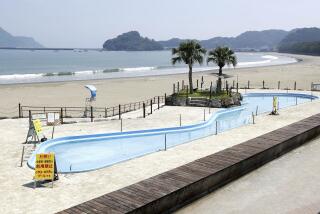Strapped Japan anxious about aging tunnels after disaster
Days after tumbling concrete killed nine people in a Japanese highway tunnel, the country is unsettled, fearful that its infrastructure could be in urgent need of repair at a time when money is scarce.
Roads and tunnels sprang up rapidly across Japan during the boom years of 1954 to 1973, said Toshiyuki Yamamoto, a professor at Nagoya University who studies transportation and traffic safety. Now that infrastructure is aging and in need of serious maintenance or replacement, just as the budget is under strain, he said.
Japan is mired in massive debt, and infrastructure costs are projected to swell 40% in the next two decades, reaching nearly $87 billion a year, according to Bloomberg.
Though Sunday’s disaster is still under investigation, officials suspect that aging bolts were behind the collapse of the Sasago Tunnel. The accident has led to soul-searching about the safety of the vast network of tunnels in the mountainous nation.
“As one of the engineers belonging to the expressway company operating the tunnel, I am very sorry for the casualties of the accident that happened on Sunday,” Tomonobu Tanino, a technical advisor to the World Road Assn., wrote in an email to The Times.
Though the cause of the collapse is still under investigation, “what I can say now is that the accident was unexpected and that it is time to seriously think about how to maintain the aging road infrastructure,” Tanino wrote.
Police on Tuesday raided the Nagoya offices of the highway operator responsible for the tunnel, amid reports that it would be investigated for negligence. Its maintenance executive told reporters that a September inspection had not included hammer tests to detect irregularities in the ceiling bolts.
Even those tests might not have revealed the problem, said Fathi Tarada, managing director of the British consulting company Mosen Ltd. Based on drawings, he believes the ceiling design itself was badly flawed. The tunnel featured concrete ceiling panels that were suspended by metal rods. Scores of such tunnels are now being examined in Japan.
“I don’t think a design like that would be accepted in the UK or in the States, either,” Tarada said.
Twenty years ago, most Japanese tunnel builders switched to a new ceiling design, the Yomiuri Shimbun newspaper reported Tuesday. However, the older design was used on some sections of the lengthy Fujikawa Tunnel that opened this year, it noted.
Japan had been praised as a leader in tunnel safety, credited for installing fire-suppression systems after earlier tragedies, and renowned internationally for buildings made to weather the country’s frequent earthquakes.
“You’ve had high-speed rail operating nearly half a century without a single fatality. You have very high construction standards for buildings and highways,” said Daniel Okimoto, professor emeritus of political science at Stanford University. “It’s a huge shock that this has happened.”
ALSO:
Israel’s deputy foreign minister dropped from election slate
Egyptian police fire tear gas during rally against President Morsi
Shelling reportedly hits school in Damascus, killing at least nine
More to Read
Sign up for Essential California
The most important California stories and recommendations in your inbox every morning.
You may occasionally receive promotional content from the Los Angeles Times.










